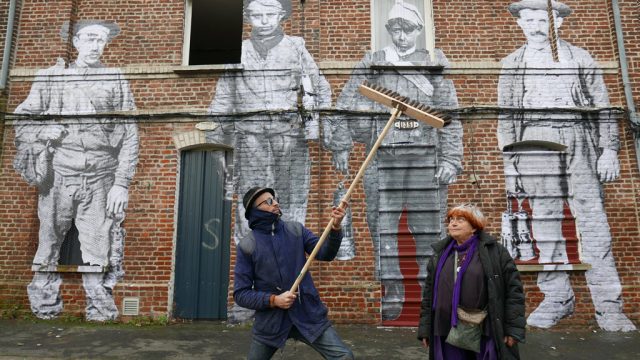We of the Solutariat love it when famous European filmmakers slip into personal documentary mode. Werner Herzog’s playful excursions into esoteric topics of natural phenomena and human extremity have long been championed in our comments section. So have the whimsically sad cinematic musings of Agnes Varda, a leading figure of the French Nouvelle Vague whose last films mulled over her increasing estrangement from mainstream society and the remembrance of her legacy. Faces Places, a collaboration with street artist JR, integrated the autobiographical with the historical, juxtaposing the literal fading of the artist’s vision against that of a disappearing rural community. It ultimately finds, and spreads, joy in both telling the story of this collaboration and in generating public art dedicated to the proposition that the images of the people they encountered won’t vanish from the public space in which they live and toil.
The movie announces its sense of fun in contrasting the collaborators’ different appearances and style sense. Varda was a squat, outgoing 90-year old imp. She is friendly, talkative, yet deeply empathetic, intently willing to listen to the subjects she encountered on her various treks across France, as displayed in this and in 2000’s The Gleaners and I. The taller, younger and leaner JR, whose colossal, publicly accessible installations of portraits of every day folk have made him a recognizable celebrity, guards his authentic self behind the patented black suit and sunglasses associated with hipster cosmopolitan detachment. In deference to the latter, Faces Places seems playfully disingenuous in chronicling the origins of their friendship, recreating scenes in which they dance in a fading ballroom or run through the Louvre, ala Bande à part. Real truth is not as important as creative wish fulfillment.
JR’s Godardian affectation to refuse removing the aforementioned glasses forms a running motif through the film. It culminates in an abortive visit to the reclusive director, who no-shows a scheduled interview. This lack of closure forms a melancholy undercurrent to the movie, communicating a sense that times sweetly remembered might not be regained through bad timing or fate. At another site, Varda remembers her friendship with the late photographer Henri Cartier-Bresson, who mentored her in cinematic technique. In an empathetic gesture, JR blows up a picture of the artist, and installs it on an abandoned German WWII bunker near a beach where he used to lie in repose. In trying to recreate a photograph she took in her twenties, Varda is not so lucky. The physical details of the location had washed away.
The sojourns into the past are instigated by a journey in the present. Both artists set out to record the faces of people of a vanishing rural and coastal plain, with JR taking photos in a large camera and blowing up the positive so it can be displayed on the sides of decrepit structures. Railway tankers, old barns, and crumbling public housing structures are transformed into epic canvases. Their subjects are reclusive artists who work and live under abandoned stairwells, dairy farmers in deserted villages, artisans of obscure crafts, and stevedores (and their weary wives) waiting for the ships that may never make it to port. One might expect, in these times of political scrutiny, that they may come off as abandoned “everymen”, people victimized by the changing tides of post industrialism’s new world order. Instead, she and JR convey their indominable perseverance, a quality of stubbornly defying the withering effects of change and circumstance. Their images, in murals and in film, are immune to the sentimentality of knee jerk leftist social realism or the saccharine charm of Capra-esque populism. They simply endure.
Since Faces Places opened in 2018, society has placed public art under increased scrutiny. Whose stories get told is now the focus of intense public debate. Eternal virtues embodied by public figures, such as military valor and political virtuosity, now seem to mask narratives that exclude or oppress people at the margin of their narratives. While we can, by public acclimation, tear down monuments to the Confederacy and its racist apologists, what do we erect in their place? JR’s work, despite its high value in the art market, suggests a path towards reclaiming what is abandoned, of remembering the people who live through an unbending will during this moment, transforming the ephemerality of the digitally captured moment into, if not a permanent, at least a long lasting testament to the belief that we are all entitled to dignity, respect, and, yes, remembrance.

